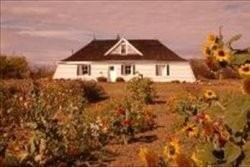Type Homestead Website Addison Sod House | Built 1909–1911 Governing body Private Residence | |
 | ||
Location Oakdale No. 320, Kindersley, Saskatchewan, Canada | ||
Addison Sod House is a Saskatchewan homestead site made of grass or sod which is over a hundred years old and has been designated as a National Historic Site of Canada.
Contents
History of site
This sod home was used by James Addison and his family 10 miles (16 km) north of Kindersley, Saskatchewan, Canada and 6.5 miles (10.5 km) east on Highway 21. His property held a barn, two sheds, shelterbelt as well as dugout. Sod houses were a popular construction choice in the early 1900s by the early homesteaders to Saskatchewan. Similar to an earth sheltering type of houses. Whereas many earth sheltering houses were built into hills, a 'soddie' had the base dug down about 3 feet (0.91 m) below the residence square footage area. A layer of buffalo, oxen or cattle chips which was then covered over with a well packed layer of clay. The walls were made of pieces of sod approximately 4 inches (100 mm) deep, 3 feet (0.91 m) wide, and 4 to 5 feet (1.5 m) long. These sod pieces were laid in overlapping fashion to construct all four walls. These walls would provide shelter in its enclosed space from precipitation, wind, heat, and the cold of 40 degree below winters, and insulation against the heat of 40 degree above summers. The roofs were generally made of aspen logs laid across the walls, and these logs covered in sod. Heavy spring rains were the main downfall of these homes as the sod on the roof, dried out from winter, and only supported with the logs would wash away with the water. Most homesteaders used the sod house as a temporary house until a wooden or brick structure was built.
This particular sod house had several unique features which has helped it to survive until this day, nearly a century after first construction. The sod chosen were from a dried up waterlogged area or a dried up slough so the grass roots were quite thick. Sods are usually overlapped when made into walls, however, Addison made a hole in the center of each sod piece so that as the piece of sod dried it would tend to crumble in on itself, rather than outwards. He also made each wall triangular, so that the width of the wall at the base was wider than the top. The roofs which were the downfall of most sod houses was not typical on Addison's Sod house. He departed from using sod for the roof, but made a wooden hip roof with wood shingles eliminating water damage from spring rains, and winter snow melting. Addison also protected his sod walls from the elements, first by growing vines, then by covering the exterior with cedar shingles. With the advent new technologies in home construction, the cedar shingles were replaced with asphalt, then with vinyl siding.
Benefits
The benefits of earth sheltering are numerous. They include: taking advantage of the earth as a thermal mass, offering extra protection from the natural elements, energy savings, providing substantial privacy, efficient use of land in urban settings, shelters requires low maintenance, and earth sheltering commonly takes advantage of passive solar building design.
The Earth's mass absorbs and retains heat. Over time, this heat is released to surrounding areas, such as an earth shelter. Because of the high density of the earth, change in the earth’s temperature occurs slowly. This is known as ‘thermal lag.’ Because of this principle, the earth provides a fairly constant temperature for the earth walled shelters, even when the outdoor temperature undergoes great fluctuation. In most of the United States, the average temperature of the earth once well below the frost line is around 55 to 57 degrees Fahrenheit (13 to 14 degrees Celsius). The depth of frost lines vary from region to region. In the USA frost lines can range from around 20" to 40+". Thus, at the base of a deep earth berm, the house is heated against an exterior temperature gradient of perhaps ten to fifteen degrees, instead of against a steeper temperature grade where air is on the outside of the wall instead of earth. In the summer, the temperature gradient actually helps to cool the house.
The reduction of air infiltration within an earth shelter can be highly profitable. Because three walls of the structure are mainly surrounded by earth, very little surface area is exposed to the outside air. This alleviates the problem of warm air escaping the house through gaps around windows and door. Furthermore, the earth walls protect against the cold winter winds which might otherwise penetrate these gaps. However, this can also become a potential indoor air quality problem. The installation of vents is key.
As a result of the thermal mass of the structure, the thermal lag of the earth, the protection against unwanted air infiltration and the combined use of passive solar techniques, the need for extra heating and cooling is minimal. Therefore, there is a drastic reduction of energy consumption required for the home compared to homes of standard construction.
Earth shelters also provide privacy from neighbors, as well as soundproofing. The ground provides acoustic protection against outside noise. This is a major benefit in urban areas or along highways with constant traffic. In urban areas, one of the other major benefits of underground sheltering is the efficient use of land. Many houses can sit below grade without spoiling the habitat above ground. Each house can have both a house and a lawn/garden within the same site.
Nearby
Affiliations
The Museum is affiliated with: CMA, CHIN, and Virtual Museum of Canada.
